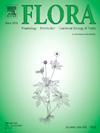海康-温带森林不同森林管理下东方山毛榉(Fagus orientalis L.)树木自然更新评价
IF 1.8
4区 生物学
Q3 ECOLOGY
引用次数: 0
摘要
森林中树木的成功更新需要幼苗的适当建立和生长。苗木的特性可以改善森林管理者在森林生态系统中应用人工造林系统的决策。在海坎-温带森林中,我们测量了不同森林管理方式下山毛榉幼苗的主要形态特征,包括单树选择、防护林制度和对照(未砍伐)地点。结果表明,不同的森林经营方式是影响苗木性状变化的最重要因素。单树和防护林采伐的小苗(H≤50 cm)在斜向性、分枝性、高度和H/D比上的平均值较高。单树选育体系下高苗(高51 ~ 150 cm)的直苗、单苗、H/D比、距种子树距离、苗数均值均高于防护林体系和对照地(p≤0.01)。在两个山毛榉幼苗高度等级(小、高)中,对照、防护林和单树选择地的一些属性差异显著(P≤0.01,P≤0.05)。本研究的主要发现有助于森林管理者了解海卡尼亚森林中山毛榉幼苗对不同采伐方式的反应。本文章由计算机程序翻译,如有差异,请以英文原文为准。
Assessing natural regeneration of oriental beech (Fagus orientalis L.) trees under different forest managements in Hyrcanian-temperate forest
The successful regeneration of trees in forests requires proper establishment and growth of seedlings. The traits of seedlings can be improving the decision- making forest managers regarding when applying silvcultural systems in forest ecosystems. We measured the major morphological traits of beech seedlings under different forest managements including single-tree selection, shelterwood systems and control(unlogged) site in Hyrcanian-temperate forest. We found that different forest managements are statistically the most important factor for the variation of seedlings traits in the forest. Small seedlings (H ≤ 50 cm) in the logged forest via single-tree selection and shelterwood showed the higher mean values regarding to plagiotropic, forked, height and H/D ratio. Tall seedlings (H:51–150 cm) in single-tree selection system had a higher mean values for seedling features including straight, single, H/D ratio, distance from seed trees and seedling number compared with shelterwood system and control site (p ≤ 0.01). Among the two beech seedlings height classes (small vs. tall), we found some attributes to differ significantly for control, shelterwood and single-tree selection sites (P ≤ 0.01, P ≤ 0.05). The main findings of our study might be favorable for forest managers to know the reaction of beech seedlings to different logging operations in Hyrcanian forests.
求助全文
通过发布文献求助,成功后即可免费获取论文全文。
去求助
来源期刊

Flora
生物-植物科学
CiteScore
3.30
自引率
10.50%
发文量
130
审稿时长
54 days
期刊介绍:
FLORA publishes original contributions and review articles on plant structure (morphology and anatomy), plant distribution (incl. phylogeography) and plant functional ecology (ecophysiology, population ecology and population genetics, organismic interactions, community ecology, ecosystem ecology). Manuscripts (both original and review articles) on a single topic can be compiled in Special Issues, for which suggestions are welcome.
FLORA, the scientific botanical journal with the longest uninterrupted publication sequence (since 1818), considers manuscripts in the above areas which appeal a broad scientific and international readership. Manuscripts focused on floristics and vegetation science will only be considered if they exceed the pure descriptive approach and have relevance for interpreting plant morphology, distribution or ecology. Manuscripts whose content is restricted to purely systematic and nomenclature matters, to geobotanical aspects of only local interest, to pure applications in agri-, horti- or silviculture and pharmacology, and experimental studies dealing exclusively with investigations at the cellular and subcellular level will not be accepted. Manuscripts dealing with comparative and evolutionary aspects of morphology, anatomy and development are welcome.
 求助内容:
求助内容: 应助结果提醒方式:
应助结果提醒方式:


